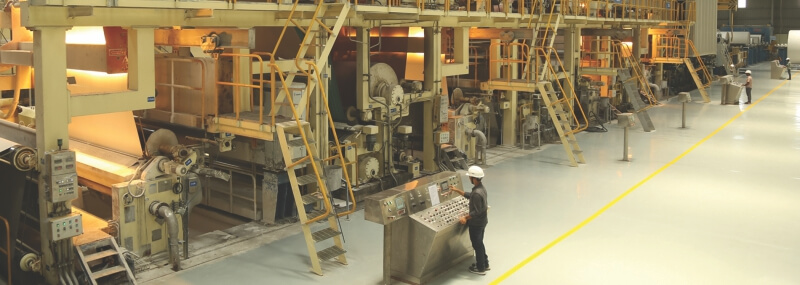This article is a part of Silver Linings to the Corona Cloud feature

Operations and Workforce Management
Before Corona
Operations were good and satisfactory.
We all were expecting overall paper demand to grow at 6-7 percent CAGR for the next 3-4 years and reach from about 19 million tonnes in 2019-20 to 24 million tonnes in 2023-24.
Workforce engagement and demand from the paper industry were increasing and bullish.
After Corona
The demand has weakened across most of the industries due to weak consumer sentiment and job losses. The consumers are deferring their non-discretionary purchases and focussing on buying essential items. The restrictions imposed to curb the spread of the virus have affected the ongoing infrastructure and other projects, thereby leading to a cascading effect on the value chain of the paper industry.
Liquidity crunch: Businesses are under pressure to meet their fixed overhead costs as their revenues have been hit due to weak demand amid pandemic-related challenges.
Workforce health and business in ‘new normal’: Maintaining the health of workers in ‘new normal’ also remains a challenging task for industries as this is further expected to add to their liquidity crunch. For the labour-intensive paper industry, the cost of labour constitutes a major figure in the supply chain.
Market demand shocks: The pandemic will result in sluggish or postponed customer demand due to reduced income levels and low sentiments due to uncertainty. The epidemic might stimulate the demand for the first-purchase opportunity but it is difficult to ascertain the magnitude of change in demand.
Supply Chain Management
Before Corona
The supply chain system was in place before COVID-19 and we all were looking for betterment and further growth.
After Corona
Supply chain disruptions: Demand shock will lead to a fall in future sales and profitability of the firms. This, combined with heightened uncertainty, will result in supply chain disruptions. Due to the high degree of integration and interdependence of value chains across the economy and lockdown, the extent of the impact on the economy will be multi-fold. India’s high dependence on imports of wastepaper will also cause major disruptions in the supply of raw materials.
The paper industry is set to see production delays, reduced shipping; and freight options, while a drop in revenue may prevent companies from meeting operational cost. Upon reopening of production units across the globe, the availability of cargo vessels/carriers will be limited, and this will not only lead to delayed shipments but also increased logistics costs.
There has also been a severe demand compression due to closing down of educational institutions, commercial establishments and downstream printers, publishers, converters, stationery services among others.
Anticipate continued supply chain disruptions: It’s truly a global industry and whether it is shipping, logistics, or other transportation issues snarled by travel bans, supply shortages, rising prices, or anything else that affects your ability to get what you need when you need it; the problems aren’t going away quickly.
Supply chains for recovered paper are under strain as local authorities close recycling facilities and businesses that are usually generating large amounts of materials for recycling are closed. UK collection volumes are down significantly.
The curb on the movement of people and non-essential goods has affected the supply chain, leading to a shortage of raw materials. The coronavirus outbreak in major raw material supplying countries has affected the movement of raw materials across the borders.
The paper industry is feeling the heat of supply chain disruptions due to their dependency on imports for most of the requirements. The supply chain disruptions have led to a longer product cycle and increased financial liabilities.
The paper dealers of India: The 10,000 paper dealers of India are the foundation of the print industry. This includes wholesale and retail and the big paper merchants. They serve as a link between a converter or printer and a wholesaler or stockist. This segment has been adversely impacted due to sluggish sales of 40 percent during the pandemic months. Now it is moderate at 60-65 percent.
Secondly, there are a lot of government compliance, rules, and regulations, which have been introduced in the last two years – things such as TDS and TCS. It becomes onerous for a single-person organisation where the owner is handling sales and managing the account engine to keep track of these compliances.
Market Scenario
Before Corona
The country’s paper sector registered a growth of about 5-6 percent last fiscal ended March 31, 2020. The biggest hope for the industry is the potential for the per capita paper consumption to go up from the present 14 kg to about 17 kg by 2024-25. The global average per capita consumption is about 57 kg.
The newsprint industry has been in decline for more than a decade because of falling demand for newsprint, magazines and impact of digitalization.
The most robust growth was seen in the packaging grades be it packaging board or kraft. The tissue also had a very good growth potential in India with increasing awareness of health and hygiene.
After Corona
The country’s paper industry is currently operating at less than 70 percent capacity utilisation due to the severe demand compression. All the segments of paper were adversely impacted, and it is only a matter of degree amongst different grades, with writing and printing and newsprint segments the worst affected.
Among various business segments within the paper industry, the packaging industry has fared well across segments — pharma sector, FMCG, and growth of the e-commerce business. Ban on single-use plastics is expected to create an alternative paper market.
One huge area of concern for the commercial print segment is the slump in the writing and printing segment. This is because of the restrictions on schools and colleges, and the boom in online education. This has impacted the demand for notebooks and textbooks. Moreover, the government restrictions on printing calendars and diaries in government departments and PSU companies are also making matters worse.
Profit Margin
Before Corona
Paper Industry as a whole was having satisfactory profit margins and expecting much better margins in coming years.
After Corona
There has been an all-round increase in input costs, across raw materials and in energy costs, as also of all sizing chemicals leading to pressure on costs.
From January 2021 onwards, some signs of recovery were witnessed, especially in packaging and paperboard, and tissue segments. After the second wave of the pandemic, the scenario dampened again for the industry from mid-April onwards with orders drying up for some segments.
The paper industry has made substantial investments in the last 5-7 years and it is becoming very difficult to meet its financial obligation in view of the significant drop in margins.
The paper industry relies on a constant supply of recycled waste paper for its source materials. This year, the collection of those recyclables has largely ceased, driving up the cost for the raw material that does exist. The paper companies are now forced to pay sky-high prices for the material they need to make paper, but, due to low demand, aren’t able to raise the prices.
Unfortunately for some companies, their margins are becoming as thin as the paper they sell. The Indian economy has been strained with working capital/liquidity crunch due to the production shutdowns and continuing payments toward fixed costs.
Expectations from the Government
Before Corona
Government policies were supportive to paper industry growth. By and large, EoDB initiatives proven to be helpful. GST implementation has become main engine of growth for the paper Industry.
After Corona
Boosting demand: In order to boost the demand, the government should offer export incentives (RoDTEP, Duty Drawback, MEIS, etc.) to the industries timely and also cut GST rates. At the same time, the government should also look at imposing import duties on certain goods (newsprint) and raw materials, which can be manufactured locally, to provide support to the domestic industries.
Enhancing supply: The government should enact ease of not just doing business but resuming, diversifying, and expanding too. It must also establish helpdesks and digital platforms to bridge the information gap between suppliers, buyers, and logistics service providers.
Liquidity support: It is one of the most critical interventions that the government should undertake immediately in order to support the businesses. This can be done by lowering duties, taxes, and GST rates, providing a quick refund of taxes, and immediate release of export and other incentives under the industrial and sectoral policies.
Easing regulatory requirements: The government should extend the timelines for existing approvals and licenses necessary for meeting compliance requirements and the operation of businesses. The auto-renewals/clearances/approvals based on self-declaration should be promoted across the industries, to manage the challenges of meeting regulatory requirements during the pandemic.
Workforce welfare: The government should issue SOPs for businesses operating in ‘New Normal’ in order to help the industries as well as safeguard the health of the workforce.
Policy interventions: The pandemic has highlighted the importance of having diverse supply sources within the country and across the globe. It is an opportune time for the government to revisit, renegotiate and enforce FTAs and other regional agreements, especially with respect to value addition clauses and changes in the import-export basket of India, to protect the local economy and increase reach beyond South Asia.
FDI: The government should increase its focus on tapping foreign investors by offering incentives to encourage FDI in the country. This will not only help in the development of supply chain infrastructure for niche products in India but also lead to increased employment generation opportunities.
Future Outlook
Before Corona
The imports of paper and paperboards, barring the newsprint into the country, have been steadily increasing. In the last nine years, imports have risen at a CAGR of 11.34 percent in value terms from INR 3,411 crore in 2010-11 to INR 8,972 crore in 2019-20.
The imports as per estimates are growing at a very high rate as compared to the increase in domestic production rate with under utilisation of domestic installed capacity.
After Corona
Having taken a major hit due to the COVID-19 lockdown, the country’s INR 80,000-crore domestic paper industry is on a consolidation mode and expects the business to get back to its normal rhythm by Q4 of FY 2021-22.
The paper industry is operating under extremely challenging conditions which have been compounded by substantial quantities of paper being imported into the country at significantly lower costs.
The print business is improving but will not return to former levels due to the switch to digital outputs, which grew during the pandemic.
The long-term outlook of the Indian paper and packaging board market remains positive with growth expected to be driven by the packaging segment. Rising imports, due to surplus capacity globally, remains a concern for domestic manufacturers.




